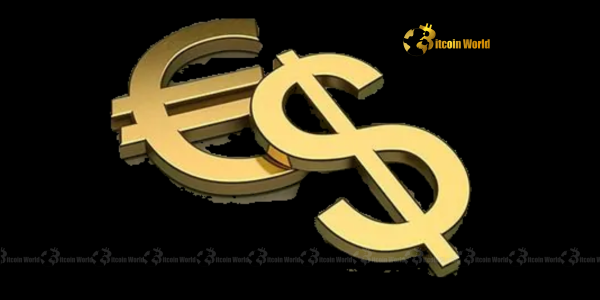Dollar Euro Exchange Rate: Unpacking the Alarming Impact of Trump’s Tariff Threats
0
0
BitcoinWorld

Dollar Euro Exchange Rate: Unpacking the Alarming Impact of Trump’s Tariff Threats
The financial world often reacts swiftly to political pronouncements, and recent developments have once again underscored this reality. When former President Trump hinted at imposing fresh tariffs on European Union goods, the reverberations were felt immediately across global currency markets. This wasn’t just a political statement; it was a trigger for significant shifts, particularly impacting the Dollar Euro exchange rate. For anyone tracking global economics, understanding these dynamics is crucial, especially as they influence everything from trade balances to investment strategies.
Dollar Euro Exchange Rate Under Pressure: What’s Driving the Shift?
The immediate aftermath of Trump’s tariff threats saw the US Dollar gain ground, while the Euro experienced a notable dip. This is a classic ‘flight to safety’ scenario combined with concerns over economic stability. Here’s a breakdown of why this happens:
- Safe-Haven Appeal: In times of uncertainty, investors often flock to assets perceived as safe, and the US Dollar typically holds this status. Geopolitical tensions, especially those involving trade, enhance this appeal.
- Economic Outlook: Tariffs on EU goods can significantly hamper European exports, potentially slowing economic growth across the continent. This negative outlook weakens the Euro’s attractiveness.
- Interest Rate Differentials: While not directly caused by tariffs, existing or anticipated differences in interest rates between the US and the Eurozone can amplify currency movements. If the US is seen as more likely to maintain higher rates, it attracts capital, boosting the Dollar.
The Dollar Euro exchange rate is a critical barometer of economic sentiment between these two major blocs. Any factor threatening trade equilibrium directly impacts this sensitive balance, creating winners and losers in the global financial landscape.
Decoding US Dollar Strength: Is it Sustainable?
The recent surge in US Dollar strength isn’t solely a reaction to tariff threats. Several underlying factors contribute to its robust position, but questions remain about its long-term sustainability. The Dollar’s role as the world’s primary reserve currency gives it inherent stability, yet its value is constantly influenced by a complex interplay of domestic and international forces.
Consider these points when evaluating the Dollar’s trajectory:
- Economic Performance: A resilient US economy, characterized by strong employment figures and controlled inflation, can bolster the Dollar. Conversely, signs of slowdown could reverse its upward trend.
- Monetary Policy: The Federal Reserve’s stance on interest rates is a major determinant. Higher rates generally make a currency more attractive to foreign investors seeking better returns.
- Global Liquidity: The Dollar’s widespread use in international trade and finance means demand for it remains high, especially during periods of global economic stress when liquidity becomes paramount.
While tariff threats can provide a short-term boost due to safe-haven flows, the enduring strength of the US Dollar will ultimately depend on the fundamental health of the US economy and the consistency of its monetary policy. Any perceived shift in these fundamentals could challenge its current dominance.
The Ripple Effect of EU Tariffs: Who Stands to Lose?
The prospect of new EU tariffs by the United States introduces a significant layer of risk for European economies and global trade alike. These aren’t just taxes; they are barriers that disrupt established supply chains, increase costs, and reduce competitiveness. The impact can be far-reaching, affecting various sectors and potentially triggering retaliatory measures.
Key areas of concern include:
- Export-Oriented Industries: European sectors heavily reliant on exports to the US, such as automotive, luxury goods, and agriculture, would face immediate pressure. Increased tariffs make their products more expensive for American consumers, potentially leading to reduced sales and production cutbacks.
- Consumer Prices: For American consumers, tariffs mean higher prices for imported European goods. This can erode purchasing power and contribute to inflation, even if the goods are not direct necessities.
- Supply Chain Disruption: Many global industries operate with complex supply chains that span continents. Tariffs can force companies to rethink their sourcing strategies, leading to inefficiencies and increased operational costs.
- Retaliation Risks: Historically, tariffs often lead to reciprocal actions. The EU could impose its own tariffs on US goods, escalating the trade dispute into a full-blown trade war that harms both economies.
The implications of EU tariffs extend beyond simple trade figures; they touch upon employment, economic stability, and international relations. Businesses are often caught in the crossfire, forced to adapt quickly to unpredictable policy shifts.
Navigating the Forex Market Analysis Amidst Uncertainty
For investors and traders, performing accurate forex market analysis becomes paramount during periods of heightened geopolitical tension. The currency market is a dynamic environment, constantly pricing in new information, and tariff threats introduce a significant element of volatility. Understanding how to interpret these signals is key to making informed decisions.
Here’s what market participants typically focus on:
- News Flow: Monitoring official statements, political rhetoric, and economic data releases is crucial. Each announcement can trigger immediate currency movements.
- Technical Indicators: Traders use charts and technical analysis tools to identify patterns and predict future price movements. Volatility indicators, support, and resistance levels become particularly important.
- Risk Sentiment: Gauging overall market sentiment – whether investors are feeling ‘risk-on’ or ‘risk-off’ – helps predict flows into safe-haven currencies like the Dollar or out of riskier assets.
- Intermarket Analysis: Observing correlations between currencies and other asset classes, such as equities, bonds, and commodities, can provide additional insights into market direction. For instance, a sell-off in European stocks alongside Euro weakness might indicate broad economic concerns.
Effective forex market analysis in such an environment requires a blend of fundamental understanding, technical prowess, and a keen awareness of the geopolitical landscape. The unpredictable nature of trade policy makes real-time adaptation a critical skill.
Global Trade Tensions: A Looming Threat to Stability?
The discussion around Trump’s potential EU tariffs is not isolated; it’s part of a broader narrative of escalating global trade tensions. In recent years, protectionist sentiments have resurfaced, challenging the long-held principles of free trade and globalization. This shift has profound implications beyond currency markets, touching upon economic growth, international cooperation, and geopolitical stability.
The concerns associated with rising trade tensions include:
- Reduced Global Growth: Trade is an engine of economic growth. When trade flows are hampered by tariffs and non-tariff barriers, global economic expansion can slow down, impacting businesses and livelihoods worldwide.
- Supply Chain Reshaping: Companies may be forced to re-evaluate and reconfigure their global supply chains, leading to higher production costs and potentially less efficient operations. This can also lead to ‘reshoring’ or ‘friend-shoring’ initiatives.
- Investment Uncertainty: Businesses are less likely to invest in new projects or expand operations when there’s significant uncertainty about future trade policies. This hesitancy can stifle innovation and job creation.
- Geopolitical Friction: Trade disputes can quickly spill over into broader diplomatic disagreements, straining international relations and making it harder to address other global challenges like climate change or security threats.
The ongoing threat of new global trade tensions serves as a stark reminder of the interconnectedness of the world economy. While nations aim to protect domestic industries, the broader consequences of protectionism can be detrimental to collective prosperity and stability.
Navigating the Uncertainty: Actionable Insights for Investors and Businesses
The recent volatility stemming from potential EU tariffs and their impact on the Dollar Euro exchange rate underscores the critical need for vigilance and adaptability. For both investors and businesses, understanding these dynamics is not just academic; it’s essential for strategic planning.
For Businesses:
- Diversify Supply Chains: Reduce reliance on single regions or countries that might become targets of tariffs. Explore alternative sourcing options to build resilience.
- Hedge Currency Exposure: For companies with significant international trade, currency hedging strategies can mitigate the risks associated with adverse currency movements.
- Monitor Policy Shifts: Stay continuously updated on trade policy announcements and geopolitical developments. Early information can provide a crucial advantage.
For Investors:
- Diversify Portfolios: Spread investments across different asset classes and geographies to reduce exposure to specific regional risks.
- Focus on Fundamentals: While headlines create short-term noise, long-term investment decisions should be based on strong economic fundamentals and sound company performance.
- Consider Safe-Haven Assets: During periods of high uncertainty, assets like gold or certain government bonds might offer a degree of protection against market downturns.
The challenges presented by escalating trade rhetoric are substantial. The unpredictable nature of political decisions means that market participants must remain agile, ready to adjust strategies in response to new information. The interplay between politics, economics, and currency markets is complex, demanding a nuanced approach to risk management.
A Compelling Summary
The recent threat of US tariffs on the European Union has once again highlighted the profound impact of geopolitical events on the global financial landscape. The immediate consequence, a stronger US Dollar and a weaker Euro, serves as a clear indicator of market apprehension. While US Dollar strength benefits from its safe-haven status, the sustainability of this trend hinges on broader economic fundamentals. The potential for widespread disruption from EU tariffs, including impacts on exports, consumer prices, and supply chains, presents significant challenges for both continents.
Navigating this environment demands robust forex market analysis, where real-time news, technical indicators, and risk sentiment are constantly weighed. Ultimately, these events are symptoms of deeper global trade tensions that threaten to reshape international commerce and cooperation. Staying informed, diversifying strategies, and maintaining flexibility are paramount for anyone looking to weather the ongoing shifts in the global economy. The future of the Dollar Euro exchange rate and global trade stability remains subject to the unfolding narrative of political and economic interactions.
To learn more about the latest Forex market trends, explore our article on key developments shaping the US Dollar and Euro exchange rates amidst global trade tensions.
This post Dollar Euro Exchange Rate: Unpacking the Alarming Impact of Trump’s Tariff Threats first appeared on BitcoinWorld and is written by Editorial Team
0
0
 Manage all your crypto, NFT and DeFi from one place
Manage all your crypto, NFT and DeFi from one placeSecurely connect the portfolio you’re using to start.




